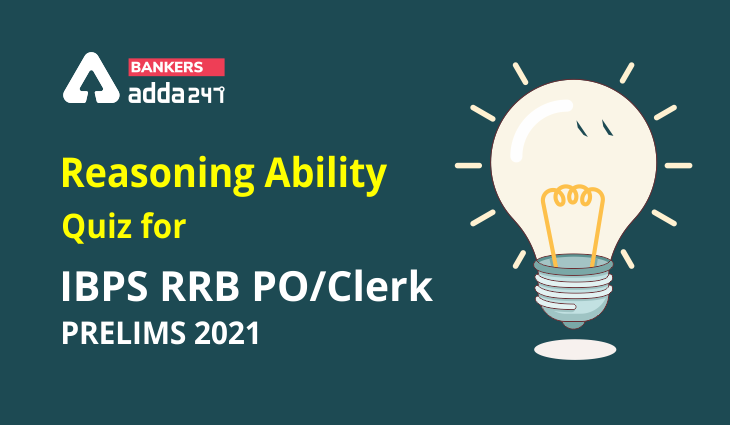Table of Contents
Directions (1–5): Study the following information carefully and answer the questions given below.
Give answer-
(a) If only conclusion I is true
(b) If only conclusion II is true
(c) If either conclusion I or conclusion II is true
(d) If neither conclusion I nor conclusion II is true
(e) If both conclusions I and II are true
Q1. Statements:
H = W, R > F, W ≤ R, F>S,
Conclusions:
I. R > H
II. R > S
Q2. Statements:
T > K, D ≥ K, M > T
Conclusions:
I. D < M
II. M ≥ D
Q3. Statements:
R ≤N, F > B, N ≥F
Conclusions:
I. N > B
II. B ≤ R
Q4. Statements:
H > W, M ≥K, W > M
Conclusions:
I. W > K
II. H ≤ M
Q5. Statements:
R ≥T, M > D≥Q, T = M,
Conclusions:
I. Q < R
II. R ≥ M
Directions (6-10): In these questions, relationship between different elements is shown in the statements. The statements are followed by conclusions.
Give answer
(a) If only conclusion I is true
(b) If only conclusion II is true
(c) If either conclusion I or II is true
(d) If neither conclusion I nor II is true
(e) If both conclusions I and II are true
Q6. Statements:
X ≥ G = H; G > J ≥ L; J ≥ K < Y
Conclusions
I. Y > L
II. K < X
Q7. Statements:
A > B = R ≥ S ≥ T; X < J ≤ K < T
Conclusions
I. T > X
II. A > J
Q8. Statements:
M > L ≥ K ≤ J; N ≥ R ≥ S = M
Conclusion:
I. N > J
II. J ≥ N
Q9. Statements:
C ≥ D = E; A = B ≤ S ≥ C
Conclusion:
I. E < A
II. B ≤ D
Q10. Statements:
X ≥ G > H ≥ I; M > H ≥ L
Conclusion:
I. X > L
II. M > I
Directions (11-15): In these questions, the relationship between different elements is shown in the statements. The statements are followed by two conclusions. Give answer
(a) if only conclusion I is true
(b) if only conclusion II is true
(c) if either conclusion I or II is true
(d) if neither conclusion I nor II is true
(e) if both conclusions I and II are true.
Q11. Statements:
G ≤ C, B > G, E > A ≥ K, B< K
Conclusions:
I. E > C
II. B ≤ C
Q12. Statements:
A ≥ K, K< M > N, B ≥ N
Conclusions:
I. A > N
II. K < B
Q13. Statements:
G > S, M ≥ N > G, R ≥ M
Conclusions:
I. G < R
II. S < M
Q14. Statements:
N ≥ M < S, R > T < J, N > R
Conclusions:
I. S < R
II. S > T
Q15. Statements:
B ≤ A < D, C ≥ E, B > C
Conclusions:
I. A ≥ E
II. E < A
Practice More Questions of Reasoning for Competitive Exams:
Solutions
S1. Ans.(b)
Sol. I. R > H (false) II. R > S(true)
S2. Ans.(d)
Sol. I. D < M (false) II. M ≥ D (false)
S3. Ans.(a)
Sol. I. N > B(true) II. B ≤ R(false)
S4. Ans.(a)
Sol. I. W > K (true) II. H ≤ M(false)
S5. Ans.(e)
Sol. I. Q < R (true) II. R ≥ M (true)
S6. Ans. (b)
S7. Ans. (e)
S8. Ans. (c)
S9. Ans. (c)
S10. Ans. (e)
S11.Ans. (d)
Sol. I. E > C (false) II. B ≤ C (false)
S12.Ans. (d)
Sol. I. A > N (false) II. K < B (false)
S13.Ans. (e)
Sol. I. G < R (true) II. S < M (true)
S14.Ans. (d)
Sol. I. S < R (false) II. S > T (false)
S15.Ans. (b)
Sol. I. A ≥ E (false) II. E < A (true)
Click Here to Register for Bank Exams 2021 Preparation Material





 GA Capsule for SBI Clerk Mains 2025, Dow...
GA Capsule for SBI Clerk Mains 2025, Dow...
 The Hindu Review October 2022: Download ...
The Hindu Review October 2022: Download ...
 RRB NTPC Exam Date 2025, Expected CBT 1 ...
RRB NTPC Exam Date 2025, Expected CBT 1 ...





